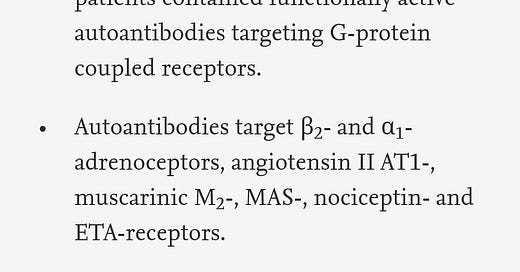Increased and Decreased G Protein-Coupled Receptor Antibody Levels as Markers for Autoimmune And Non-Autoimmune Diseases
Any extracts used in the following article are for non commercial research and educational purposes only and may be subject to copyright from their respective owners.
Don't mess with your G-protein coupled receptors.
And especially leave your kids GPCR's alone.
What Makes Antibodies Against G Protein-Coupled Receptors so Special? A Novel Concept to Understand Chronic Diseases (2020)
Abstract
Expressions of G protein-coupled receptors (GPCR) on immune and tissue resident cells are the consequence of the cellular environment, which is highly variable. As discussed here, antibodies directed to GPCR (GPCR abs), their levels and correlations to other abs, serve as biomarkers for various diseases. They also could reflect the individual interplay between the environment and the immune system. Thus, GPCR abs could display pathogenic chronic conditions and could help to identify disease-related pathways. Moreover, by acting as ligands to their corresponding receptors, GPCR abs modulate autoimmune as well as non-autoimmune diseases. This article introduces GPCR abs as drivers for diseases by their capability to induce a specific signaling and by determining immune cell homeostasis. The identification of the individual GPCR ab function is challenging but might be pivotal in the comprehension of the aetiology of diseases. This, hopefully, will lead to the identification of novel therapeutic strategies. This article provides an overview about concepts and recent developments in research. Accordingly, GPCR abs could represent ideal candidates for precision medicine. Here, we introduce the term antibodiom to cover the network of abs with GPCR abs as prominent players.
Keywords: G protein-coupled receptors, anti-G protein-coupled receptor antibodies, immune cell homeostasis, precision medicine, angiotensin receptor 1
…
Increased and Decreased G Protein-Coupled Receptor Antibody Levels as Markers for Autoimmune And Non-Autoimmune Diseases
Increased abs against self-antigens are a feature of autoimmune diseases. Indeed, high GPCR abs are associated with several rheumatic autoimmune diseases such as with SSc, systemic lupus erythematosus (SLE), or primary Sjogren’s syndrome (2, 18–21). In SSc, AT1R abs as well as ETAR abs are increased and predict vascular complications such as pulmonary arterial hypertension as well as mortality and response to therapies (18, 19). Nevertheless, higher GPCR abs compared to healthy individuals are common in human pathophysiology and were also found in endocrinological diseases (Graves’ Disease or Hashimoto thyroiditis), in gynaecology (preeclampsia), cardiac diseases (heart transplantation, cardiomyopathy, chronic heart failure, orthostatic hypotension, and postural tachycardia syndrome), or in neurologic diseases such as in dementia, Alzheimer Disease, chronic fatigue syndrome (myalgic encephalomyelitis), or in complex regional pain syndromes (6, 13, 20–23).
Full paper:
https://www.ncbi.nlm.nih.gov/pmc/articles/PMC7770155/
Functional autoantibodies against G-protein coupled receptors in patients with persistent Long-COVID-19 symptoms (2021)
Abstract
Impairment of health after overcoming the acute phase of COVID-19 is being observed more and more frequently. Here different symptoms of neurological and/or cardiological origin have been reported. With symptoms, which are very similar to the ones reported but are not caused by SARS-CoV-2, the occurrence of functionally active autoantibodies (fAABs) targeting G-protein coupled receptors (GPCR-fAABs) has been discussed to be involved.
We, therefore investigated, whether GPCR-fAABs are detectable in 31 patients suffering from different Long-COVID-19 symptoms after recovery from the acute phase of the disease.
The spectrum of symptoms was mostly of neurological origin (29/31 patients), including post-COVID-19 fatigue, alopecia, attention deficit, tremor and others. Combined neurological and cardiovascular disorders were reported in 17 of the 31 patients. Two recovered COVID-19 patients were free of follow-up symptoms. All 31 former COVID-19 patients had between 2 and 7 different GPCR-fAABs that acted as receptor agonists. Some of those GPCR-fAABs activate their target receptors which cause a positive chronotropic effect in neonatal rat cardiomyocytes, the read-out in the test system for their detection (bioassay for GPCR-fAAB detection). Other GPCR-fAABs, in opposite, cause a negative chronotropic effect on those cells. The positive chronotropic GPCR-fAABs identified in the blood of Long-COVID patients targeted the β2-adrenoceptor (β2-fAAB), the α1-adrenoceptor (α1-fAAB), the angiotensin II AT1-receptor (AT1-fAAB), and the nociceptin—like opioid receptor (NOC-fAAB). The negative chronotropic GPCR-fAABs identified targeted the muscarinic M2-receptor (M2-fAAB), the MAS-receptor (MAS-fAAB), and the ETA-receptor (ETA-fAAB). It was analysed which of the extracellular receptor loops was targeted by the autoantibodies.
https://www.sciencedirect.com/science/article/pii/S2589909021000204




